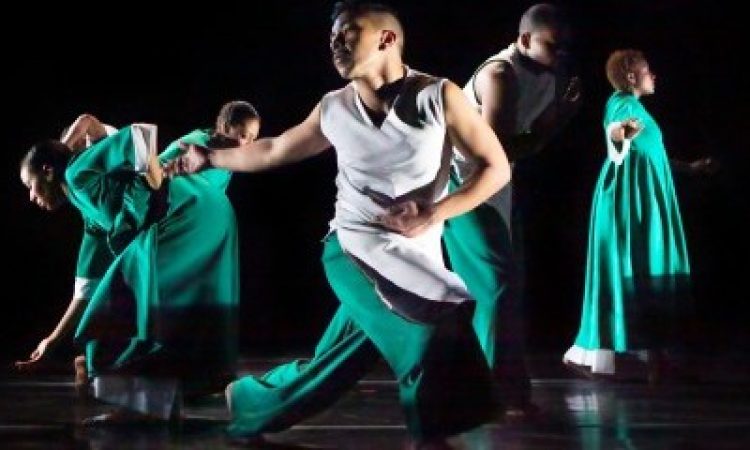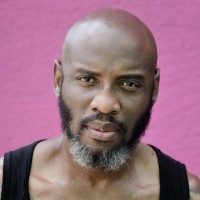“I enjoy doing Brown’s works because they are about the human condition. The storytelling makes it really accessible to the audience. The grounded movement makes the experience spiritual and the lifted quality makes me feel free.” – Arcell Cabuag
Influenced by dances from Gabon, Ivory Coast, Congo, Senegal, the West Indies, and blended with Ronald K. Brown’s modern dance training and his experiences with Mary Anthony and Jennifer Muller, the aesthetics of Brown’s company, Evidence, may be seen as African dances blended with hip hop. But Arcell Cabuag, eighteen-year company veteran and Bessie Award winning performer, says in a phone interview as he was preparing to travel with the company to Pittsburgh that, “It’s all that and so much more because the style includes storytelling and the essence of house dance.” He explains that, when he performs, it’s like indulging in a five-course meal that leaves him full.
Although I couldn’t see him, I could hear the excitement in his voice when he talked about dancing Brown’s work. He humbly spoke about setting Brown’s work on different schools and companies and when asked what type of dancers he liked to work with, he replied “open, receptive and willing.”
Many may see Evidence as a black company but Cabuag quickly defends that notion by saying “although the company is a representation of the African American experience, the work is multi-cultural in its appeal and allows us to dance our individual truths.” Self and identity are important parts of what make Evidence special and Cabuag relishes in the fact that his heritage, his beliefs, his insecurities, his struggles, and his triumphs are all expressed through movement. It’s hard to see the company perform, and not be moved by the sense of community the dancers bring to the work. They transport you, often times “taking you to church,” as some would say when referring to heightened celebratory display. After seeing the company perform several times, I completely understood when Cabuag said “It’s hard to not feel connected to God.”
Wearing many hats for the company, Cabuag acts as company manager, web designer, dancer, and associate artistic director. Although this may seem like a lot to most people, the 40 year old, 5’5’ native Californian is exactly where he wants to be, doing exactly what he wants to do. Cabuag is stand out in more ways than one: he is the only Filipino in the mostly African American company, he’s the oldest, and he’s the shortest. But when onstage, he becomes a dynamic, energetic, and spirited mover who is robust in his quality and full-bodied in his commitment. Never shrinking himself, Cabuag expands with each step, adding length to his frame and a youthful vigor to his phrasing.
Cabuag confesses to watching Solid Gold, Soul Train, Star Search, and videos of Janet Jackson when he was growing up. But his real interest in dance was revealed when he auditioned for Music Man in elementary school. Choreographer Charlie McGowan offered Cabuag the lead role and approached him to ask where he was taking classes. Cabuag explained that he wasn’t taking classes and McGowan insisted that he enroll in some dance classes after declaring, “You are a dancer!”
Approaching the 30th anniversary performance at The Joyce Theater in New York City, Cabuag reflects on the first time he saw the company rehearse in the old Alvin Ailey studios in 1997. Brown was rehearsing Ailey II in one of the studios and Cabuag watched, thinking it was a class. He was drawn to the movement and the house music being used so he asked the director of the school at the time, Denise Jefferson, to add Brown’s class to his schedule. Jefferson told him it wasn’t a class but a rehearsal, and he could only attend the audition if he were in the higher levels. He was not. Cabuag remembers being in ballet class when Brown was conducting his audition, and he asked his teacher’s permission to go the restroom as a ruse to sneak in. Once in, serendipitously, he was selected by Brown to be a part of his piece. Cabuag was home.
A visionary, Cabuag looks at the company with the long term in mind. “I envision a school where we can educate young dancers on the dances of the company,” Cabuag says. “I would like our curriculum to include all aspects of performing as well as drumming classes.” He is committed to the company’s outreach programs, appropriately named “On Earth Together,” as they embrace community participants, allowing them a chance to perform with the company on stage.
Having traveled to places like Mexico, Nigeria, Cuba, Spain, and France, Cabuag reminisced on a time when they were in Hungary and the ovation of the audience warranted three curtain calls. He expressed that in moments like those, he felt blessed. When asked how much longer he thinks he’ll dance with the company, he responded, “for as long as my body lets me!”
Cabuag will take the stage in his 18th season with Evidence at the Joyce theater in New York.
Ronald K. Brown/Evidence, The Joyce Theater, Feb. 24-March 1, www.joyce.org/performances






